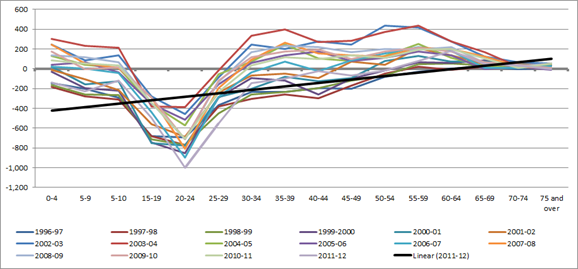While immigrants on employment visas (as opposed to humanitarian and family visas) tend to be younger and more educated that the domestic population, there is little evidence that they are meeting the needs of employers in terms of skill shortages in regional and resource boom areas. Most migrants flock to the metropolitan areas of Sydney and Melbourne, and given the conditions of the visa preventing access to welfare benefits in the first two years of arrival, migrants need to accept any employment offer, often crowding out domestic workers which at times also results in a dampening effect on wages, particularly in a competitive employment market as we are now experiencing. It is estimated that migration contributes around 100,000 migrants to the workforce every year; however in 2012 only 115,000 jobs were created in Australia. Not only are migrants not meeting skills shortage requirements, but their mass contribution to population growth not only puts pressure on existing infrastructure and pushes up costs, it creates further skill shortages in non-critical jobs to meet the demands of an increasing population, ‘justifying’ further high levels of immigration. There is also evidence that the current high immigration and settlement in metropolitan areas is influencing domestic migration and the sea and tree change phenomena, creating similar infrastructure bottlenecks in regional and rural areas as being experienced in cities. To cater for this increasing demand, governments (federal, state and local) are required to provide the necessary infrastructure and services to support the population (as expected from a first world country).
Given there is not a bottomless bucket of public money to spend, governments must decide how best to direct their revenue to support its population. For a nation projected to grow from a population of 23 million in 2013 to 36 million in 2050, this spend is currently committed to city-building infrastructure. This is despite the fact that the Commonwealth Government identifies in the 2010 Intergenerational Report that higher productivity is the key to balancing the needs of a changing demographic.
Until the government determines the appropriate level of immigration to meet the needs of the current population, public money will be directed to supporting population growth as a result of immigration rather than to productivity-enhancing initiatives, such as information telecommunications, education and training, innovation support, research and development and regulatory reform. As a consequence, it is likely that Australia will continue to report woeful productivity performance.

